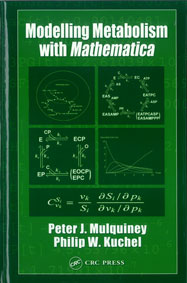|
|

Description
This book presents the approaches, methods, tools, and algorithms for modelling the chemical dynamics of metabolic pathways. Included are an introduction to the basic procedures for representing metabolic systems as arrays of differential equations as well as an explanation of the necessary Mathematica procedures for numerically solving these differential equations. Mathematica is also used to dynamically simulate simple, intermediate, and complex systems in enzyme kinetics. The book enables its readers to formulate their own models of time-dependent metabolic systems and aids them in the quest for relevant discoveries that remain to be made. Using the tools in this book, the authors wrote the paper Mathematical Modelling of the Urea Cycle. A Numerical Investigation into Substrate Channelling. A notebook (UCsim_fmr.nb) for this paper is available for download. A description of this paper is below. Metabolite channelling, the process in which consecutive enzymes have confined substrate transfer in metabolic pathways, has been proposed as a biochemical mechanism that has evolved because it enhances catalytic rates and protects unstable intermediates. Results from experiments on the synthesis of radioactive urea [Cheung, C., et al., (1989) J. Biol. Chem. 264, 4038-4044] have been interpreted as implying channelling of arginine between argininosuccinate lyase and arginase, in permeabilized hepatocytes. To investigate this interpretation further, a mathematical model of the urea cycle was written, using Mathematica; it simulates time courses of the reactions. The model includes all relevant intermediates, peripheral metabolites, and subcellular compartmentation. Analysis of the output from the simulations supports the argument for a high degree of, but not absolute, channelling and offers insights for future experiments that could shed more light on the quantitative aspects of this phenomenon in the urea cycle and other pathways. Contents Introduction to Chemical Kinetics and Numerical Integration | Elements of Enzyme Kinetics | Basic Procedures for Simulating Metabolic Systems | Advanced Simulation of Metabolic Pathways | Metabolic Control Analysis | Parameter Estimation | Model of Erythrocyte Metabolism | Metabolic Control Analysis of Human Erythrocyte Metabolism | Appendices Related Topics Chemistry, Life Sciences |
|
|
